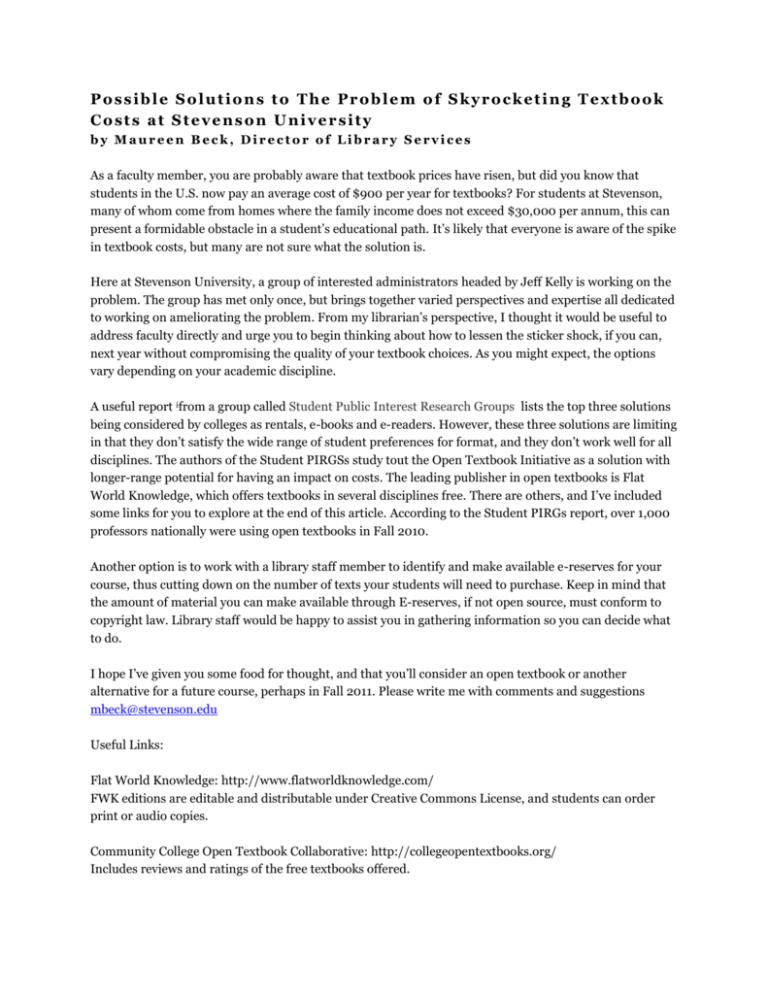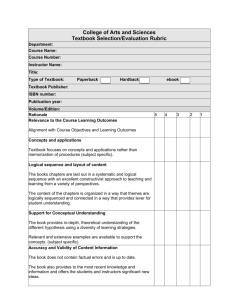The Problem of Skyrocketing Textbook Costs
advertisement

Possible Solutions to The Problem of Skyrocketing Textbook Costs at Stevenson University by Maureen Beck, Director of Library Services As a faculty member, you are probably aware that textbook prices have risen, but did you know that students in the U.S. now pay an average cost of $900 per year for textbooks? For students at Stevenson, many of whom come from homes where the family income does not exceed $30,000 per annum, this can present a formidable obstacle in a student’s educational path. It’s likely that everyone is aware of the spike in textbook costs, but many are not sure what the solution is. Here at Stevenson University, a group of interested administrators headed by Jeff Kelly is working on the problem. The group has met only once, but brings together varied perspectives and expertise all dedicated to working on ameliorating the problem. From my librarian’s perspective, I thought it would be useful to address faculty directly and urge you to begin thinking about how to lessen the sticker shock, if you can, next year without compromising the quality of your textbook choices. As you might expect, the options vary depending on your academic discipline. A useful report ifrom a group called Student Public Interest Research Groups lists the top three solutions being considered by colleges as rentals, e-books and e-readers. However, these three solutions are limiting in that they don’t satisfy the wide range of student preferences for format, and they don’t work well for all disciplines. The authors of the Student PIRGSs study tout the Open Textbook Initiative as a solution with longer-range potential for having an impact on costs. The leading publisher in open textbooks is Flat World Knowledge, which offers textbooks in several disciplines free. There are others, and I’ve included some links for you to explore at the end of this article. According to the Student PIRGs report, over 1,000 professors nationally were using open textbooks in Fall 2010. Another option is to work with a library staff member to identify and make available e-reserves for your course, thus cutting down on the number of texts your students will need to purchase. Keep in mind that the amount of material you can make available through E-reserves, if not open source, must conform to copyright law. Library staff would be happy to assist you in gathering information so you can decide what to do. I hope I’ve given you some food for thought, and that you’ll consider an open textbook or another alternative for a future course, perhaps in Fall 2011. Please write me with comments and suggestions mbeck@stevenson.edu Useful Links: Flat World Knowledge: http://www.flatworldknowledge.com/ FWK editions are editable and distributable under Creative Commons License, and students can order print or audio copies. Community College Open Textbook Collaborative: http://collegeopentextbooks.org/ Includes reviews and ratings of the free textbooks offered. Ebrary Academic Collection: http://site.ebrary.com/lib/vjc While technically not textbooks, there may be titles suitable for your upper level course here. You have over 50,000 titles from which to choose, spanning many disciplines. Ask a librarian for help linking from Blackboard if you need assistance. Green Tea Press: http://www.greenteapress.com/ Free books for computer programmers interested in learning Python, java, c++. Open Textbook Catalog: http://www.studentpirgs.org/open-textbooks/catalog Brings together open textbooks from several publishers. MERLOT’s Open Textbook Initiative: http://taste.merlot.org/opentextbooks.html You may already know MERLOT as a clearinghouse for high quality digital learning materials. The link provided here takes you directly to a list of over 900 open textbooks. Textbook Rentals Sites include Chegg.com andBookRenter.com . i A Cover to Cover Solution : How Open Textbooks Are the Path to Textbook Affordability, by Nicole Allen, The Student PIRGS, 2010.








